Christianity and Homosexuality - 'The Garden of Earthly Delights' Has It All
Decoding the most creative analogy of human vices
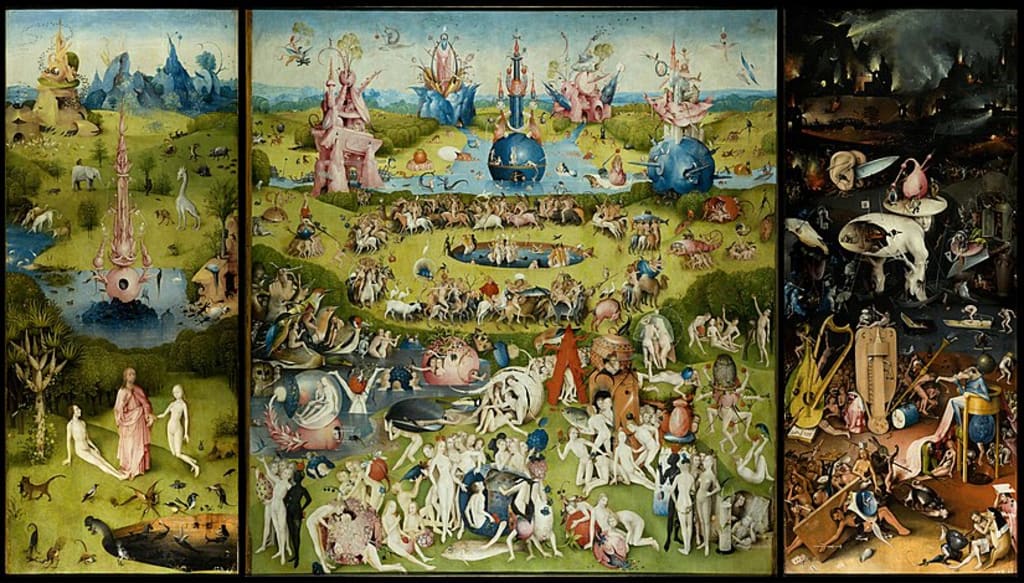
Hieronymus Bosch's The Garden of Earthly Delights is a visual dictionary that talks about biblical narratives, religious sentiments and human morality.
Each element in this masterpiece is filled with symbolism, which is mind-boggling, unsettling and leaves us with many questions.
Let's unravel the most elaborate depiction of the three panels.
---
Left Panel
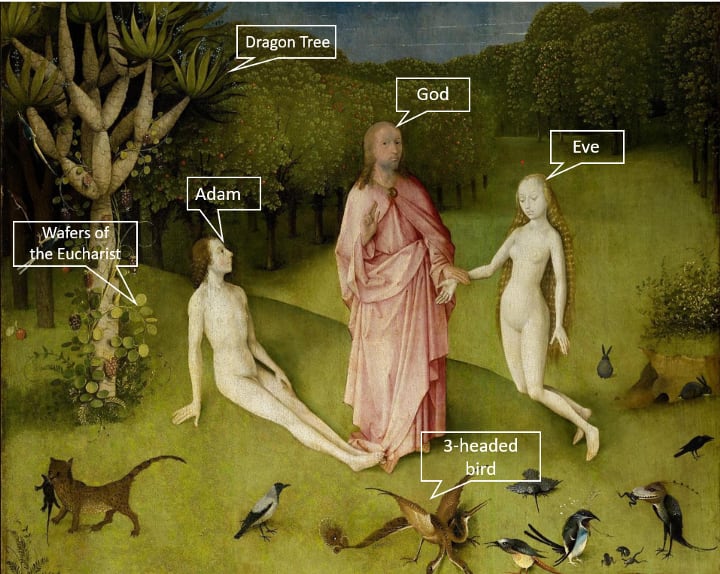
• Adam and Eve are in the garden of expulsion. In medieval times, the presence of Christ was common in the garden of Eden.
• Behind them is the tree of life - the Dragon blood tree, which, when cut, releases dark red resin just like blood. The wafers of the Eucharist are present on this tree.
• Eve is on the left side of Christ. Left depicted sinister in medieval times. The date palm present behind Eve symbolizes the tree of resurrection.
• Ugly fantastical creatures are present in the pond. The 3-headed bird points to the Trinity. Peacock, duck, wild boar, elephant, monkey, unicorn, horse and giraffe are present. Many of these animals were seen for the first time in this painting.
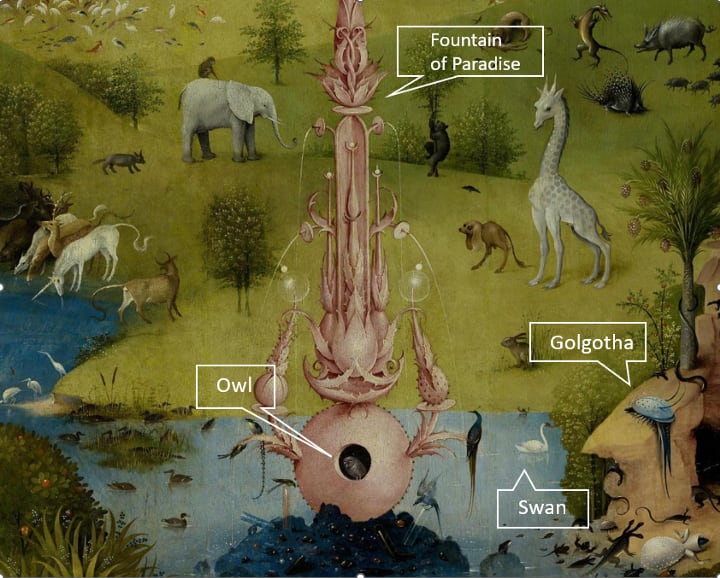
• The 'Fountain of Paradise' is on the vertical axis and matches the color of Christ's robe. It is a Christian symbol associated with baptism and eucharist - the symbol of life and fertility.
• The owl watches from the bottom circular hole.
• The swan near the fountain represents purity and the virgin Mary.
• An unusual rock formation is in the form of a weeping face called Golgotha - The Place of the Skull. It was believed that Adam's skull was buried in a cave. This rock formation inspired Salvador Dali for his painting The Persistence of Memory.
---
Center panel
At first glance, this panel seems chaotic. But as we stare at it for a while and enlarge the panel, it depicts the pleasure zone.
Bosch depicted lust, homosexuality and sexual connotations of different fruits.
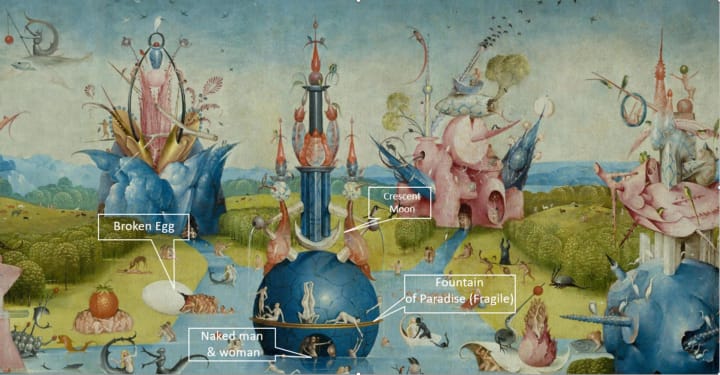
• The fountain in this panel is broken and fragile. There are no direct sexual acts except the one in the hole of the fountain where a man shamelessly touches the crotch of a woman.
• The crescent moon on the fountain shows the Turks - the enemy of Christianity in the middle ages.
• The empty mussel shells, broken eggs and carcasses represent emptiness.
---
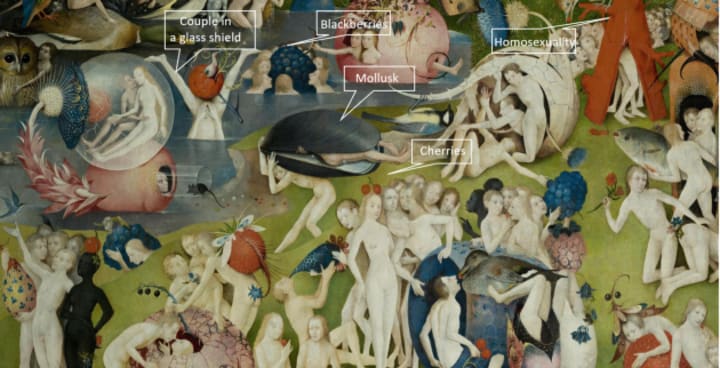
• The hollowed-out fruits represent female genitalia. Two cherries on a naked woman show male genitalia.
• On the left, a couple attached to the umbilical cord of a large flower is trapped in the circular glass showing that pleasure is transient.
• The orange tent shows men turning their buttocks to the viewer. Sign of homosexuality and sodomy.
• All fruits have sexual connotations. Blackberries with multiple seeds depict promiscuity.
---
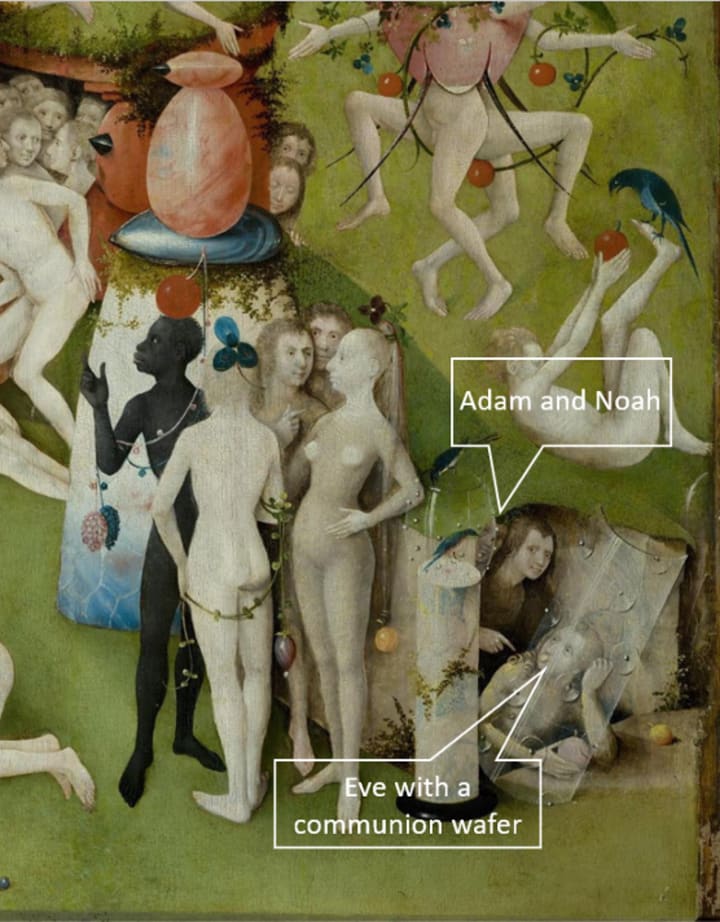
• Adam and Eve are present in the bottom right corner. Eve is encased in a cylindrical glass shield with a communion wafer gagged in her mouth. This portrayal is theologically controversial. It appears that eve's voice is intentionally silenced.
• Other mortals are encased in different glass shields.
• Behind Adam, there is a man with wine leaves. He could be Noah.
• The black-colored humans here and there represent Turks or Muslims.
---
Right panel
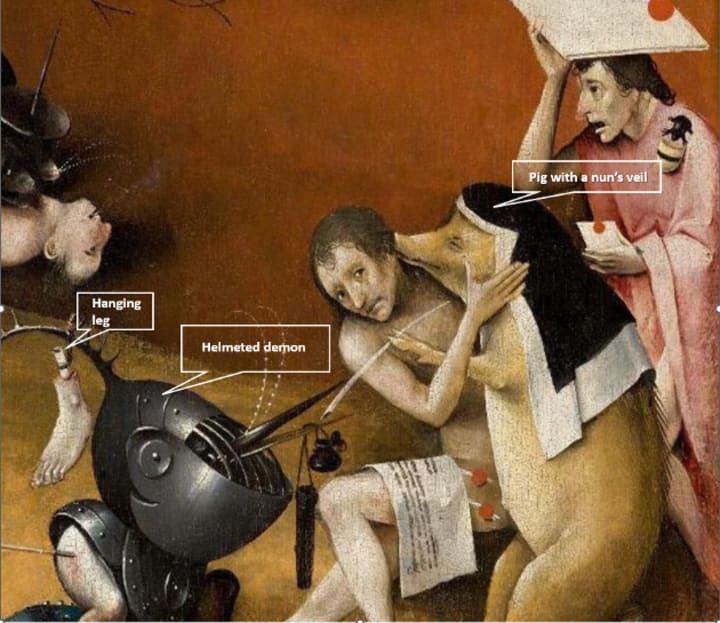
• The right lowermost corner shows a pig adorning a nun’s veil. The pig has a quill in his hand and convinces a naked man to sign a legal document. Notice the red seal.
• The helmeted demon offers a seal and the man standing beside the pig holds a pile of sealed documents. Notice a black toad on the henchman. The toad was a symbol of sin and corruption in medieval iconography.
What does it signify?
In the medieval era, “indulgences” became common in the Church. It was like a contract between the Church and a man to reduce the severity of his punishments and pave their path to heaven. In other words, paying silver or gold to buy purgation from the Church.
I mean, seriously?
These “purchases of Indulgences” soon got corrupted and the wealthy people started bribing bishops and priests. This seems to be a significant trigger for Protestant reformation.
• A hanging leg on the helmeted demon could be because of “ergot.” Ergot was a fungus that grew on wheat and got popularized as ergotism, also known as “St. Anthony’s Fire” or “Devil’s curse.”
In the 20th century, it was identified that ergot fungus contained psychoactive substances used to synthesize LSD.
----

• As we move to the lowermost left of the panel, a man is nailed to the board. The fantastical characters are drawn with so much conviction that they blend well in Bosch’s hell puzzle. The weird-looking monster squeezes the man’s neck.
• The dices and cards reveal men’s pleasure.
• The hand of the god, which balances a dice, is stabbed with a knife. It means the killing of morality and the beginning of sin.
• A blindfolded man has a sword skewered through his neck.
• The naked woman looks like a Dutch prostitute, holding a candle and pitcher.
• A man hides with his hunchback propagates a theological phrase called Incurvatus in se, a life lived inward for oneself rather than outward for God.
• The hare carries an inverted naked woman. “The hunted carrying the hunter.”
• The wild hounds attack a man.
---

• This snapshot covers the “7 deadly sins”, as enumerated by Pope Gregory in AD 590.
1. Greed — A man is excreting coins in a cesspool.
2. Gluttony — Another one vomits his own food in the cesspool.
3. Pride — A naked woman with an uncanny resemblance to Eve and a toad crawling up her breasts. Her mirror image is visible in the buttocks of a demon.
4. Sloth — A man sleeps while a toad crawls over his body.
• An owl-shaped man, known as “Prince of Hell,” sits on the potty chair and simultaneously consumes and excretes a human. Other humans are drowning in the cesspool.
• The Turks with the crescent moon hide behind the “Prince of Hell.”
----
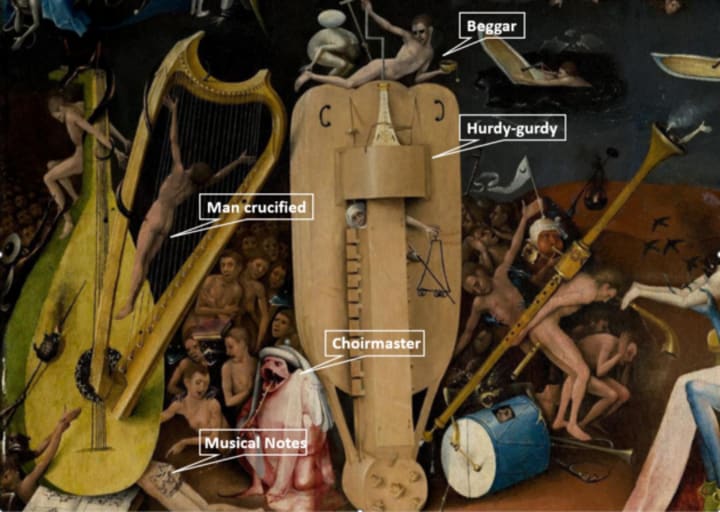
• This snapshot shows how non-religious music was considered sinful during those times.
• The pig-shaped choirmaster yells and the musical notes are imprinted on the giant buttocks of a man. Little trivia — this musical note is transcribed in modern music.
• A man is crucified on a giant harp with a toad burning near his side. Crucifixion in hell? What does it signify? I feel Bosch depicted the group of people who condemned the Church.
• A blind man lies on an inverted hurdy-gurdy with a naked man balancing an egg beside him — another depiction of Incurvatus in se.
• A demon beats the drum roll with a naked man captured inside.
• The man holds an Ottoman flag above a man playing the trumpet.
----
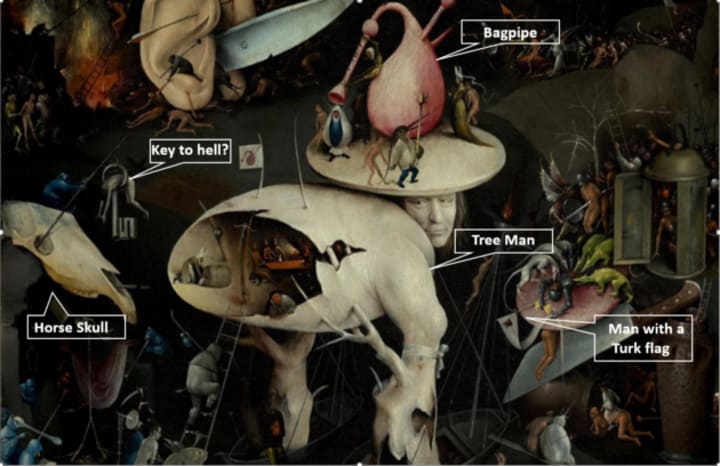
• The “tree man” shows a calm self-portrait of Bosch. His torso is a broken egg. People are partying inside the tavern and the tree man is balanced on a small boat. A bagpipe flag hoists on the broken egg.
• The giant bagpipe on Bosch’s head depicts the erotic instrument due to its similarities with a man’s scrotum and penis. It also shows strange couples together, perhaps portraying “Beastiality?”
• A giant knife in between the ears and a needle pierced shows the sufferings in hell.
• A horse skull shows that death is inevitable and a man swinging through a giant key shows the “key to hell.”
• A group of toads attacks a man and he seems to be a leader of an army. He holds the Ottoman flag. What does it suggest?
• Another man climbs the ladder. Is it the ladder of hell?
---
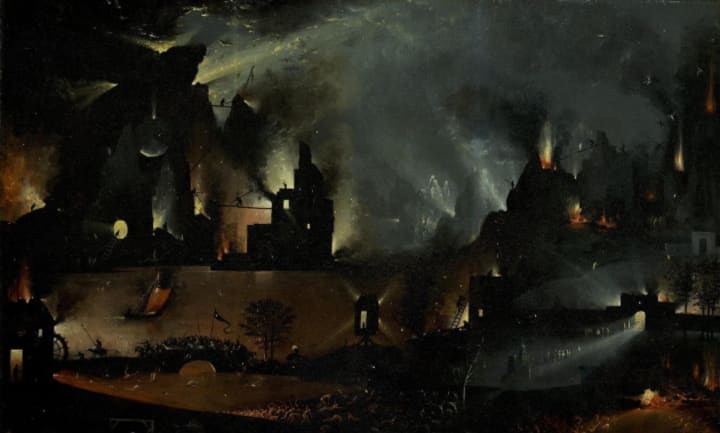
The view of hell? An army of demons passes through the bridge.
The end is nigh!
----
My next ebook '10 Paintings to See Before You Die' is out.
This book curates the 10 most famous paintings for art history lovers who wish to dig deeper and analyze art and artists.
About the Creator
Kamna Kirti
Art enthusiast. I engage with art at a deep level. I also share insights about entrepreneurship, founders & nascent technologies.
https://linktr.ee/kamnakirti



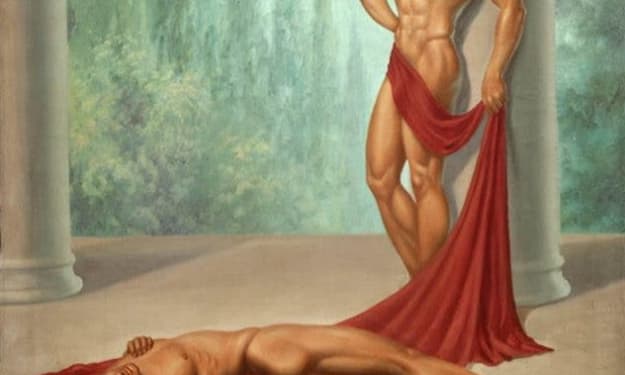



Comments (2)
I have a large triptych of this painting in my apartment. This story has helped me enjoy it even more.
Love your perspective on this classic.